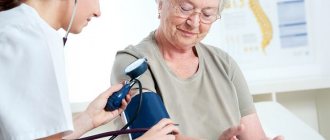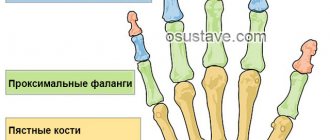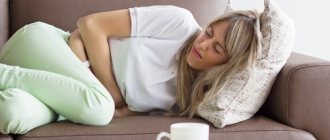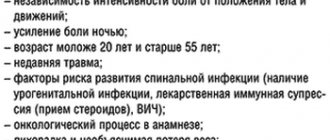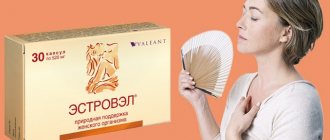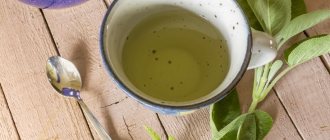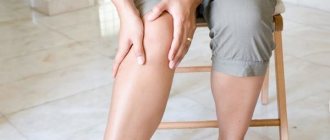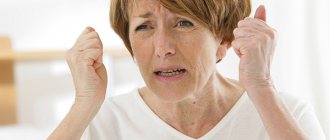Causes of discomfort
The answer to the question of why joints hurt during menopause will be given by a specialist, based on the individual characteristics of the patient. Usually during menopause, a woman’s body suffers from hormonal changes. There is a decrease in the level of hormones produced by the ovaries. Due to a decrease in estrogen levels, characteristic menopausal symptoms occur:
- Sudden emotional changes;
- Feeling of flushing in the face;
- Dryness of the genitals;
- Joint pain.
On a note!
Pain in joints and muscles during menopause needs to be monitored by a doctor.
Symptoms of decreased estrogen levels in the body
Typically, discomfort develops as a result of certain disorders:
- Osteoporosis. This disease is formed against the background of altered bone tissue, thereby causing its depletion. As a result of hormonal imbalance during menopause, bones become fragile. Because of this, more stress is placed on the joints. First, pain appears due to increased pressure on bone tissue. Further, a violation of the cartilaginous structure of the joint develops, increasing discomfort;
- Deforming osteoarthritis, which manifests itself as stiffness of movement in the morning. This occurs due to decreased synthesis of collagen, which nourishes the joints. What causes them to wear out quickly?
- Obesity. Due to a decrease in the production of hormones during menopause, excessive accumulation of adipose tissue is observed in the body. This causes excess weight gain, which increases the load on bone tissue and provokes pain;
- Deterioration of blood flow, causing a decrease in muscle tone;
- Failure in the functioning of the nervous system. Typically, during menopause, women often complain of cramps that have a negative impact on the joint.
Physiotherapy for joint pain
If your joints hurt during menopause, if the pain becomes regular and almost unbearable, the most reasonable decision would be not to self-medicate, but to immediately consult a doctor. The doctor will conduct a thorough examination, prescribe the necessary tests, and only after that will he be able to accurately determine how to treat joints during menopause.
Among the most effective methods is physiotherapy.
- Electrophoresis. The essence of this method is that, using a special device, direct current penetrates deep into the skin. In turn, this contributes to the cartilage receiving anti-inflammatory and pain-relieving drugs. As a result, blood circulation improves, tissues warm up and pain decreases.
- Ultrasound therapy. Another effective treatment method for joint pain during menopause. During the procedure, the doctor uses a device that emits sound waves at a very high frequency. The range of such sound radiation varies from 20 kilohertz to 1 megahertz. The procedure has a mechanical effect, which can be compared to a deep, but barely noticeable, vibration massage of the tissues. As a result of this procedure, the inflamed area is reduced, and the production of synovial fluid is stabilized, which leads to normal painless work.
- Magnetic therapy. This method for treating pain in the muscles of the arms and legs during menopause is also often prescribed to patients. Using a special device, the doctor acts locally on problem (painful) areas with a magnetic field. Such a field can be either variable or constant; both low frequency and high frequency. With this procedure, the depth of tissue heating is 2-3 centimeters. As a result, inflammatory processes decrease and pain disappears.
- Ultraviolet irradiation. The essence of this technique is that the skin is irritated by electromagnetic waves, the penetration depth of which is on average 1 millimeter. Thanks to the processes caused by the impact of these waves, the pain syndrome is significantly reduced, as well as the inflamed area. However, it is worth considering that there are serious contraindications for using this method, including: mental problems, stomach ulcers, malignant tumors, tuberculosis, thrombophlebitis.
- Infrared laser therapy. Most often, this technique is used to treat pain in the elbow and knee joints. The essence of the procedure is that under the influence of an infrared laser, the sensitivity of nerve endings is significantly reduced, due to which pain disappears. Also, as a result of infrared laser therapy, blood circulation improves and inflammation decreases.
Types of pain
Women during menopause suffer from dull joint pain. Pain occurs for no reason, without connection with external factors. Usually discomfort increases in the evenings, and stiffness is felt in the morning. Joint pain is combined with:
- Fatigue, constant drowsiness;
- Increased irritability;
- Tides;
- Increased sweating;
- Inability to walk for a long time.
Pain during menopause is often associated with weather conditions. The pain often “radiates” to the lumbar region.
Symptoms that occur along with joint pain during menopause
Do joints really hurt during menopause?
Often women doubt whether the menopause is really so difficult and has such a detrimental effect on the condition of the body.
As medical practice shows, menopause is really difficult to bear.
This is primarily due to the fact that this period is accompanied by hormonal changes in the body.
At the same time, there is always a decrease in the production of estrogen and progesterone - the most important female hormones. The activity of the genitourinary organs and the central nervous system depends on their quantity, and they also influence the condition of the epidermis.
Most women who have insufficient production of these biologically active substances suffer from constant mood swings, excessive dryness of the mucous membranes of the genital organs and severe pain in the joints.
How to deal with pain
Before treating joint pain during menopause, it is important to visit an endocrinologist, neurologist, gynecologist, or orthopedist. Specialists will help determine the cause of the pain. Typically the following diagnostics are required:
- X-ray, which allows you to determine the presence of an altered condition in the bone;
- Wider survey. For this, MRI and CT are prescribed;
- A blood test that determines the level of synthesized hormones;
- Osteodensitometry allows you to determine how much bone damage has occurred.
Hormone replacement therapy
Treatment of joint pain during menopause is based on medications that increase the production of sex hormones. They help replenish the substances the body lacks and stop the process of joint depletion. The woman's cramps and pain disappear. To eliminate joint pathologies caused by menopause, the following is prescribed:
- Klymen;
- Klimonorm;
- Premarin;
- Angelique;
- Cyclo-Proginov.
These medications are available in the form of tablets, patches, and injections. They help prevent calcium from being washed out of the body. Which reduces the severity of pain. Sometimes a woman cannot take hormonal medications. In this situation, it is necessary to replace them with homeopathy and herbal products. Experts recommend taking the following types of medications:
- Climaxana;
- Remens;
- Klimakt-Helya;
- Estrovela;
- Klimadinona.
Medicines to increase estrogen levels
Treatment methods
What to do if your joints hurt during menopause, the doctor will tell you only after diagnosis. But regardless of the root cause of the pathology, therapy usually begins with adjusting the hormonal levels. To normalize it, a woman will have to take hormonal medications and change her diet.
Drug therapy
The only effective way to eliminate pain is to take hormonal medications. Painkillers will give a short-term effect, since pain will appear precisely due to a lack of sex hormones.
Also, a woman will definitely need to take a course of multivitamins, which will help strengthen the immune system and saturate the cartilage with essential vitamins and microelements. The most popular drugs for menopause are:
- Retinol. Vitamins of group A should be taken daily, 10 drops in the morning and evening.
- Ascorbic acid. It is recommended to consume ascorbic acid three times a day for 20 days.
- Vitamins of group D. Patients are usually prescribed 2 tablets, but the dosage in any case should be selected only by the attending physician.
- Aquadetrim and Vigantol. Drugs that help restore calcium deficiency.
- Rumalon. Chondoprotector of animal origin, which strengthens the strength of cartilage fibers. The product is available in the form of an injection solution.
- Trental. This remedy helps normalize blood circulation. The standard dosage involves taking 2 tablets in the morning, afternoon and evening. The duration of therapy is determined by the doctor.
- Voltaren. Gel for external use with anti-inflammatory and anti-edematous effects. It is recommended to treat the problem area 2 times a day.
- Ibuprofen. A non-steroidal anti-inflammatory drug with a pronounced analgesic effect.
- Angelique. A hormonal drug designed to normalize the condition during menopause.
- Klimara. A patch intended for hormone therapy. It must be attached to the same place for 7 days, and after this period, replaced with a new one and attached to another place.
Also, to treat muscle pain during menopause, doctors often prescribe homeopathic and herbal remedies to women. They are especially often prescribed to women who, for one reason or another, cannot resort to hormonal drugs. The most famous drugs in this category are Remens, Klimaksan and Klimadinon.
Reference! Taking medications intended to normalize the condition should only be taken with the approval of a doctor. Although most of the above remedies are available without a prescription, if used incorrectly they can cause complications and only worsen the situation.
Folk recipes
To relieve pain and eliminate symptoms, you can also use traditional methods of treatment. But it is important to remember that their help can only be used as auxiliary means; the main treatment should be carried out with the help of medications.
The most effective recipes are:
- applying a cabbage leaf to the problem area;
- taking baths with the addition of sea salt;
- dandelion juice Several flowers and stems need to be crushed and mixed together with sugar (in proportions 1:1). Place the resulting mixture in the refrigerator for 10 days. After this time, you need to squeeze out the dandelion juice and take it every day before meals (a teaspoon).
To achieve a positive effect, you will have to use folk recipes for at least 4-6 months.
Diet
Adjusting your diet will also help reduce pain in joints and bones during menopause. After menopause, a woman should consume as many foods as possible that are high in calcium, phosphorus, magnesium and zinc. You should also exclude fast food and foods oversaturated with carcinogens from your diet, as they can cause weight gain, which is absolutely unacceptable.
The most useful products for menopause are the following:
- lean meat;
- sea fish and seafood;
- oatmeal;
- boiled and baked potatoes;
- bran;
- nuts;
- asparagus;
- garlic.
To prevent the development of complications, it is advisable to avoid using salt, seasonings and spices.
Calcium-containing medications
To eliminate joint pain during menopause, it is recommended to use calcium supplements. Its quantity supplied with food is not enough to meet the needs of a woman’s body during menopause. Calcium-containing vitamins are an addition to the main treatment. For this purpose they prescribe:
- Vigantola;
- Aquadetrima;
- Alfacalcidol.
Important!
Women during menopause are prescribed vitamin preparations with vitamin D, which promotes better absorption of calcium.
In addition to the treatment of joints, medications containing large doses of minerals that increase bone density are used. For this they take:
- Kaltsinova;
- Natekal;
- Nycomed.
Often, to restore the balance, bisphosphonates are prescribed, which inhibit the effects of substances that have a pathogenic effect on the bone tissue of the joint. For this purpose they prescribe:
- Fosavance;
- Aklasta;
- Fosmax.
Chondroprotectors
As a result of the changes occurring in the body caused by menopause, bones undergo a degenerative process. Joint pathologies lead to the development of osteoarthritis, arthritis, and osteoporosis. The presence of any joint disease must be treated with chondoprotectors, which promote cartilage renewal. For these purposes the following are prescribed:
- Rumalon;
- Artron;
- Arteparon.
Important!
For treatment to bring maximum benefit, it is necessary to reduce high loads on the affected joint.
Chondroprotectors and other medications for joint pain during menopause
Causes of joint pain during menopause
Osteoporosis
The changes occurring in a woman’s body are a consequence of the decline of reproductive function, and with it the hormonal levels. The importance and role of hormones in the normal functioning of a woman’s body cannot be overestimated. Hormonal balance is the main regulator of processes occurring in a woman’s body.
Why do joints hurt during menopause, and women regularly face this problem? The fact is that the body is no longer able to synthesize the required amount of hormones. And since hormones normalize metabolic processes in cartilage tissue and participate in the formation of connective tissue, a decrease in their production causes a lot of unpleasant sensations in the weaker half.
ethnoscience
In addition to the basic treatment of joints, traditional medicine methods are used. They help strengthen bones and eliminate pain. Before starting therapy with traditional methods, you should consult your doctor. It will help assess the condition of the body and the possibility of using alternative treatment. Popular recipes:
- To relieve pain and eliminate swelling, apply a fresh cabbage leaf, previously beaten to obtain more juice;
- Mix crushed dandelion flowers with sugar. The components are taken in equal proportions. Leave for 2 weeks in a dark, cool place. Filter the resulting juice, take 1 tsp three times. before eating;
- Sea salt baths will help eliminate swelling of the affected joint.
Other methods
During menopause, women are advised to do dosed physical activity. They need to avoid intense training and long runs. Walking, swimming, aerobics, yoga, exercise therapy will be useful. Physiotherapy has found widespread use:
- Mud baths;
- Electrophoresis with hormonal agents;
- Thermotherapy;
- Laser therapy.
Other methods of treating joint pain during menopause
Causes of aches and pain in the joints during menopause
Menopause, postmenopause and menopause are 3 conditions that follow each other starting at the age of 45 years. Characterized by a total restructuring of the body. First of all, the production of sex hormones decreases. These substances are responsible not only for the condition and functioning of the reproductive system. They regulate many processes in the body, so their deficiency leads to a number of changes. This affects the physical condition of the woman. And it often manifests itself as painful sensations in the joints. Joints may hurt during menopause and menopause for the following reasons:
- Excess weight - an increase in body fat - is the body's response to stopping the production of estrogen. Excess body weight is an additional load on the joints of the lower extremities, especially the knees.
- Poor blood circulation in soft tissues is associated with a decrease in the concentration of substances such as elastin and collagen. This leads to a decrease in muscle tone.
- Changes in the functioning of the central nervous system are the cause of frequent cramps and joint pain.
Diet features
Women who are in menopause need proper nutrition. Its task is to eliminate the gain of extra pounds. The diet should be as rich as possible in calcium, vitamins, and phytoestrogens. The daily menu should consist of:
- Foods rich in potassium. To do this, you need to eat potatoes, pumpkin, beans, oatmeal, prunes;
- A diet rich in phosphorus. These components are found in bran, meat, nuts, legumes, fish;
- Dishes with increased amounts of zinc, boron, magnesium. Garlic, peaches, wheat porridge, and strawberries contain these components in large quantities.
Recommended products increase the strength of bone tissue and tone muscle tissue. It is necessary to limit salt intake. Sodium contained in salty foods has a negative effect on the cardiac system and inhibits metabolic processes. It is important to eat fractionally, at least 5 times a day in small portions.
What to do if muscles and joints hurt during menopause - joint pain during menopause needs medical attention. Prescribing adequate treatment allows a woman to lead a full life.
